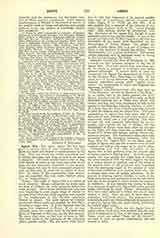

Agnus Dei.—The name Agnus Dei has been given to certain discs of wax impressed with the figure of a lamb and blessed at stated seasons by the Pope. They are sometimes round, sometimes oval or oblong, and they vary from an inch to six inches in diameter. The lamb usually bears a cross or flag, while figures of saints or the name and arms of the Pope are also commonly impressed on the reverse. These Agnus Deis may be worn suspended round the neck, or they may be preserved as objects of devotion. In virtue of the consecration they receive, they are regarded, like holy water, blessed palms, etc., as “Sacramentals“.
ORIGIN.—The origin of Agnus Deis is a matter of much obscurity. Recent authorities lay stress upon the lack of evidence for their existence before the ninth century. But it seems probable that they had their beginning in some pagan usage of charms or amulets, from which the ruder populace were weaned by the employment of this Christian substitute blessed by prayer. The early history of Catholic ceremonial affords numerous parallels for this Christianizing of pagan rites. It is not disputed that the Agnus Deis originated in Rome. If so, we may probably trace the custom back to the final over throw of Paganism in that city, say the fifth century. We know that when we first hear of them (c. 820) they were made of the remnants of the preceding year’s paschal candle. We also know from Ennodius (c. 510) that fragments of the paschal candles were used as a protection against tempests and blight (Migne, P.L., LXIII, pp. 259, 262). It is also possible that a mention of the blessing of wax under Pope Zosimus (418) in the “Liber Pontificalis” (first edition) should be interpreted, with Msgr. Duchesne, of the Agnus Dei, though it more probably refers to the paschal candle. It was at this period and before the Trullan Council of 691 that the symbolism of the Lamb most flourished; see the Sarcophagus of Junius Bassus. The alleged examples of early Agnus Deis, e.g. one of Gregory the Great in the treasury of Monza (see Kraus, “Real-Encyclopadie,” s.v.) cannot be trusted. The earliest certain specimen now in existence seems to belong to the time of Gregory XI (1370).
HISTORY.—From the time of Amalarius (c. 820) onwards we find frequent mention of the use of Agnus Deis. At a later period they were often sent by the Popes as presents to sovereigns and distinguished personages. A famous letter in verse accompanied the Agnus Dei despatched by Urban V to the Emperor John Palaeologus in 1366. In the penal laws of Queen Elizabeth Agnus Deis are frequently mentioned among other “popish trumperies” the importation of which into England was rigorously forbidden.
BLESSING AND DISTRIBUTION.—We learn from an “Ordo Romanus” printed by Muratori (“Lit. Rom.”, II, p. 1,004) that in the ninth century the Archdeacon manufactured the Agnus Deis early on Holy Saturday morning out of clean wax mixed with chrism, and that they were distributed by him to the people on the Saturday following (Sabbato in Albis). At a later date the Pope himself generally assisted at both the blessing and the distribution. The great consecration of Agnus Deis took place only in the first year of each pontificate and every seventh year afterwards, which rule is still followed. The discs of wax are now prepared beforehand by certain monks, and without the use of chrism. On the Wednesday of Easter week these discs are brought to the Pope, who dips them into a vessel of water mixed with chrism and balsam, adding various consecratory prayers. The distribution takes place with solemnity on the Saturday following, when the Pope, after the “Agnus Dei” of the Mass, puts a packet of Agnus Deis into the inverted mitre of each cardinal and bishop who comes up to receive them.
SYMBOLISM AND USE.—The symbolism of the Agnus Deis is best gathered from the prayers used at various epochs in blessing them. As in the paschal candle, the wax typifies the virgin flesh of Christ, the cross associated with the lamb suggests the idea of a victim offered in sacrifice, and as the blood of the paschal lamb of old protected each household from the destroying angel, so the purpose of these consecrated medallions is to protect those who wear or possess them from all malign influences. In the prayers of blessing, special mention is made of the perils from storm and pestilence, from fire and flood, and also of the dangers to which women are exposed in childbirth. It was formerly the custom in Rome to accompany the gift of an Agnus Dei with a printed leaflet describing its many virtues. Miraculous effects have been believed to follow the use of these objects of piety. Fires are said to have been extinguished, and floods stayed. The manufacture of counterfeits, and even the painting and ornamentation of genuine Agnus Deis, has been strictly prohibited by various papal bulls.
MARTYRS’ PASTE.—There are also Agnus Deis of a grey color, made from wax mingled with the dust which is believed to be that of the bones of martyrs. These, which are called “Paste de’ SS. Martiri”, are held to need no special consecration and are treated as relics.
HERBERT THURSTON

